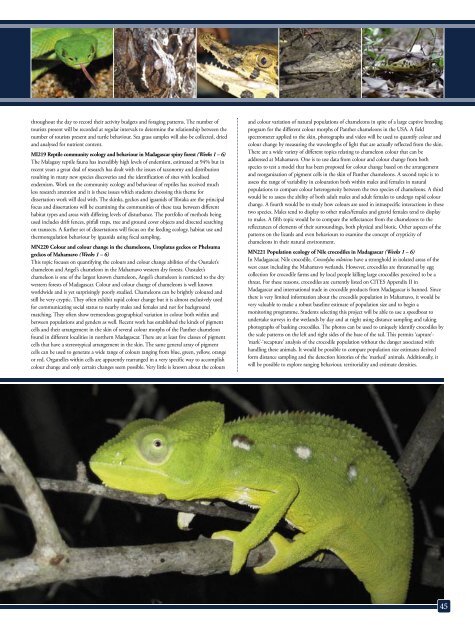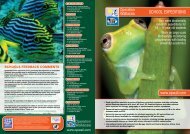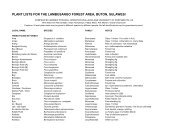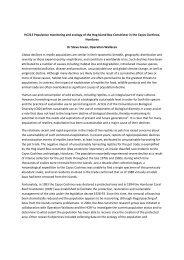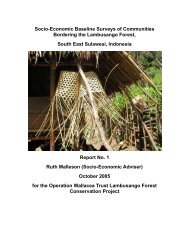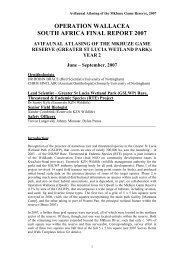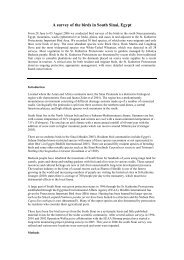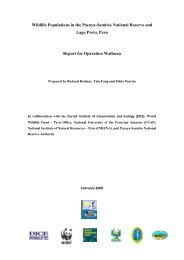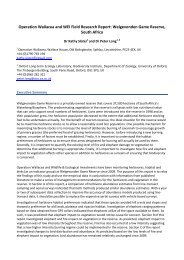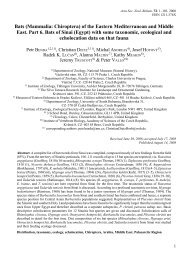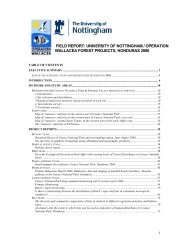Download the 2013 programme - Operation Wallacea
Download the 2013 programme - Operation Wallacea
Download the 2013 programme - Operation Wallacea
You also want an ePaper? Increase the reach of your titles
YUMPU automatically turns print PDFs into web optimized ePapers that Google loves.
throughout <strong>the</strong> day to record <strong>the</strong>ir activity budgets and foraging patterns. The number of<br />
tourists present will be recorded at regular intervals to determine <strong>the</strong> relationship between <strong>the</strong><br />
number of tourists present and turtle behaviour. Sea grass samples will also be collected, dried<br />
and analysed for nutrient content.<br />
MI219 Reptile community ecology and behaviour in Madagascar spiny forest (Weeks 1 – 6)<br />
The Malagasy reptile fauna has incredibly high levels of endemism, estimated at 94% but in<br />
recent years a great deal of research has dealt with <strong>the</strong> issues of taxonomy and distribution<br />
resulting in many new species discoveries and <strong>the</strong> identification of sites with localised<br />
endemism. Work on <strong>the</strong> community ecology and behaviour of reptiles has received much<br />
less research attention and it is <strong>the</strong>se issues which students choosing this <strong>the</strong>me for<br />
dissertation work will deal with. The skinks, geckos and iguanids of Ifotaka are <strong>the</strong> principal<br />
focus and dissertations will be examining <strong>the</strong> communities of <strong>the</strong>se taxa between different<br />
habitat types and areas with differing levels of disturbance. The portfolio of methods being<br />
used includes drift fences, pitfall traps, tree and ground cover objects and directed searching<br />
on transects. A fur<strong>the</strong>r set of dissertations will focus on <strong>the</strong> feeding ecology, habitat use and<br />
<strong>the</strong>rmoregulation behaviour by iguanids using focal sampling.<br />
MN220 Colour and colour change in <strong>the</strong> chameleons, Uroplatus geckos or Phelsuma<br />
geckos of Mahamavo (Weeks 1 – 6)<br />
This topic focuses on quantifying <strong>the</strong> colours and colour change abilities of <strong>the</strong> Oustalet’s<br />
chameleon and Angel’s chameleon in <strong>the</strong> Mahamavo western dry forests. Oustalet’s<br />
chameleon is one of <strong>the</strong> largest known chameleon, Angel’s chameleon is restricted to <strong>the</strong> dry<br />
western forests of Madagascar. Colour and colour change of chameleons is well known<br />
worldwide and is yet surprisingly poorly studied. Chameleons can be brightly coloured and<br />
still be very cryptic. They often exhibit rapid colour change but it is almost exclusively used<br />
for communicating social status to nearby males and females and not for background<br />
matching. They often show tremendous geographical variation in colour both within and<br />
between populations and genders as well. Recent work has established <strong>the</strong> kinds of pigment<br />
cells and <strong>the</strong>ir arrangement in <strong>the</strong> skin of several colour morphs of <strong>the</strong> Pan<strong>the</strong>r chameleon<br />
found in different localities in nor<strong>the</strong>rn Madagascar. There are at least five classes of pigment<br />
cells that have a stereotypical arrangement in <strong>the</strong> skin. The same general array of pigment<br />
cells can be used to generate a wide range of colours ranging from blue, green, yellow, orange<br />
or red. Organelles within cells are apparently rearranged in a very specific way to accomplish<br />
colour change and only certain changes seem possible. Very little is known about <strong>the</strong> colours<br />
and colour variation of natural populations of chameleons in spite of a large captive breeding<br />
program for <strong>the</strong> different colour morphs of Pan<strong>the</strong>r chameleons in <strong>the</strong> USA. A field<br />
spectrometer applied to <strong>the</strong> skin, photographs and video will be used to quantify colour and<br />
colour change by measuring <strong>the</strong> wavelengths of light that are actually reflected from <strong>the</strong> skin.<br />
There are a wide variety of different topics relating to chameleon colour that can be<br />
addressed at Mahamavo. One is to use data from colour and colour change from both<br />
species to test a model that has been proposed for colour change based on <strong>the</strong> arrangement<br />
and reorganization of pigment cells in <strong>the</strong> skin of Pan<strong>the</strong>r chameleons. A second topic is to<br />
assess <strong>the</strong> range of variability in colouration both within males and females in natural<br />
populations to compare colour heterogeneity between <strong>the</strong> two species of chameleons. A third<br />
would be to assess <strong>the</strong> ability of both adult males and adult females to undergo rapid colour<br />
change. A fourth would be to study how colours are used in intraspecific interactions in <strong>the</strong>se<br />
two species. Males tend to display to o<strong>the</strong>r males/females and gravid females tend to display<br />
to males. A fifth topic would be to compare <strong>the</strong> reflectances from <strong>the</strong> chameleons to <strong>the</strong><br />
reflectances of elements of <strong>the</strong>ir surroundings, both physical and biotic. O<strong>the</strong>r aspects of <strong>the</strong><br />
patterns on <strong>the</strong> lizards and even behaviours to examine <strong>the</strong> concept of crypticity of<br />
chameleons in <strong>the</strong>ir natural environment.<br />
MN221 Population ecology of Nile crocodiles in Madagascar (Weeks 1 – 6)<br />
In Madagascar, Nile crocodile, Crocodylus niloticus have a stronghold in isolated areas of <strong>the</strong><br />
west coast including <strong>the</strong> Mahamavo wetlands. However, crocodiles are threatened by egg<br />
collection for crocodile farms and by local people killing large crocodiles perceived to be a<br />
threat. For <strong>the</strong>se reasons, crocodiles are currently listed on CITES Appendix II in<br />
Madagascar and international trade in crocodile products from Madagascar is banned. Since<br />
<strong>the</strong>re is very limited information about <strong>the</strong> crocodile population in Mahamavo, it would be<br />
very valuable to make a robust baseline estimate of population size and to begin a<br />
monitoring <strong>programme</strong>. Students selecting this project will be able to use a speedboat to<br />
undertake surveys in <strong>the</strong> wetlands by day and at night using distance sampling and taking<br />
photographs of basking crocodiles. The photos can be used to uniquely identify crocodiles by<br />
<strong>the</strong> scale patterns on <strong>the</strong> left and right sides of <strong>the</strong> base of <strong>the</strong> tail. This permits ‘capture’-<br />
‘mark’-‘recapture’ analysis of <strong>the</strong> crocodile population without <strong>the</strong> danger associated with<br />
handling <strong>the</strong>se animals. It would be possible to compare population size estimates derived<br />
form distance sampling and <strong>the</strong> detection histories of <strong>the</strong> ‘marked’ animals. Additionally, it<br />
will be possible to explore ranging behaviour, territoriality and estimate densities.<br />
45


